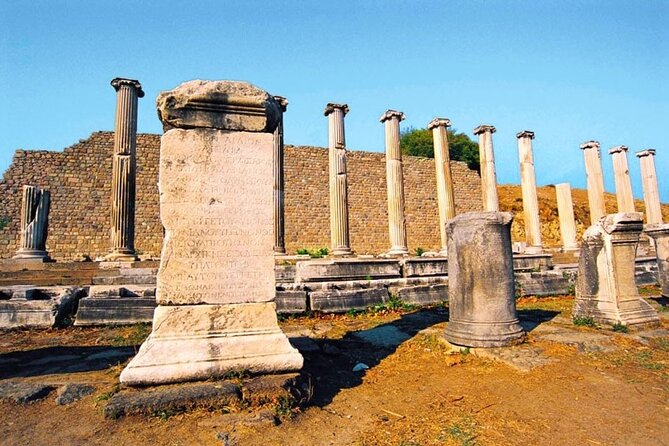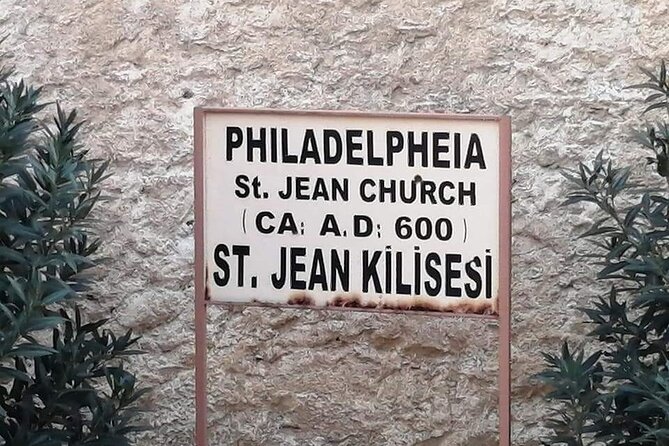The Seven Churches of Revelation stand as magnificent testaments to the ancient Christian faith, captivating believers and historians alike with their rich history and profound spiritual significance. These churches, nestled within the picturesque landscapes of modern-day Turkey, were not just ordinary places of worship; they were the recipients of divine letters, filled with praise, admonition, and prophecy from the apostle John himself.
As the sun rises over the ruins of these once-thriving communities, one can’t help but wonder about the secrets they hold within their ancient walls – secrets of faith, endurance, and the eternal struggle between good and evil. Step into the world of the Seven Churches of Revelation, where the past whispers through the stones, and a journey of discovery awaits.
Good To Know
- The Seven Churches of Revelation were located in Asia Minor and played a crucial role in the spread of Christianity.
- Each church had unique challenges and strengths, showcasing the diversity and resilience of early Christians.
- The churches are documented in the Book of Revelation and continue to inspire believers today.
- The architectural grandeur, religious art, and active involvement of women in leadership positions highlight the enduring legacy and contributions of these churches.
Historical Background

The Historical Background of the Seven Churches of Revelation provides crucial context for understanding the significance and impact of these ancient Christian communities. These seven churches, located in Asia Minor (modern-day Turkey), played a pivotal role in the spread of Christianity in the early years. The legacy of these churches can still be felt today.
Each church had its own unique challenges and strengths, which are documented in the Book of Revelation. The impact of these churches extends beyond their historical significance. They serve as a reminder of the trials and triumphs of the early Christian community, and their legacy continues to inspire believers around the world.
Exploring the historical background of these churches allows us to gain a deeper understanding of the impact they had on the development of Christianity.
Find more activities and experiences we've covered in Izmir.
Church of Ephesus

Located in Asia Minor, the Church of Ephesus stands as a testament to the vibrant and influential early Christian community that once thrived within its walls. Today, only archaeological ruins remain of this ancient church, but its religious significance can’t be understated.
It was in Ephesus that the apostle Paul spent three years ministering and establishing the church, making it one of the most important centers of early Christianity. The ruins of the church reveal its grandeur, with remnants of ornate mosaics, towering columns, and intricate carvings.
As visitors walk through the site, they can imagine the fervor of worship and the teachings that once echoed through its halls. The Church of Ephesus continues to inspire awe and reverence, reminding us of the enduring legacy of faith.
Church of Smyrna
Enjoy the rich history and enduring faith of the Church of Smyrna, a testament to the resilience and steadfastness of early Christians. Smyrna, now modern-day Izmir in Turkey, was one of the seven churches mentioned in the Book of Revelation. The church played a significant role in early Christianity and faced intense persecution.
During the early years of Christianity, Smyrna became a center of opposition towards Christians. The city was known for its strong loyalty to the Roman Empire and its dedication to emperor worship. As a result, Christians in Smyrna faced persecution and were subjected to severe trials and tribulations.
Despite the hardships, the Church of Smyrna remained steadfast in their faith, refusing to renounce their beliefs. Their unwavering commitment to Christianity made Smyrna an important symbol of resistance against persecution.
To visually engage the audience, here is a table highlighting the key aspects of the Church of Smyrna:
| Church of Smyrna | |
|---|---|
| Location | Izmir, Turkey |
| Importance | Significant role in early Christianity and resistance against persecution |
| Persecution | Intense persecution of Christians in Smyrna |
| Faith | Steadfast commitment to Christianity |
| Enduring Legacy | Symbol of resilience and endurance in the face of adversity |
The Church of Smyrna serves as a powerful reminder of the courage and determination displayed by early Christians in the face of persecution.
Church of Pergamum

Discover the intriguing history and profound influence of the Church of Pergamum, a vibrant community that played a pivotal role in the spread of Christianity and confronted its own unique challenges.
The Church of Pergamum was known for its magnificent church architecture, showcasing the grandeur and splendor of the faith. The religious art within the church was a testament to the devotion and creativity of the community, with intricate mosaics and stunning frescoes adorning the walls.
The church’s architecture and religious art served as a powerful means of communication, conveying the stories and teachings of Christianity to both believers and non-believers. The Church of Pergamum stood as a symbol of faith and resilience, embodying the spirit of the early Christian community in the face of persecution and adversity.
Church of Thyatira
The Church of Thyatira, known for its vibrant community and influential presence, held a significant role in the spread of Christianity and faced its own unique set of challenges. One of the notable aspects of the Church of Thyatira was the role of women in religious practices. Unlike some of the other churches, Thyatira embraced the active involvement of women in leadership positions and spiritual activities. These women played a crucial part in the growth and development of the church. Plus, Thyatira was known for its diverse religious practices, which included participation in trade guilds. However, this acceptance of different practices also led to a struggle with idolatry and immorality within the church. Despite these challenges, the Church of Thyatira remained resilient and made significant contributions to the early Christian movement.
| Role of Women | Religious Practices | Challenges |
|---|---|---|
| Active involvement of women in leadership positions | Participation in trade guilds | Struggle with idolatry and immorality |
Common Questions

How Do I Book a Tour to Visit the Seven Churches of Revelation?
To book a tour to visit the Seven Churches of Revelation, simply follow the booking process offered by popular tour operators. They make it easy to secure your spot and explore these historic sites.
What Is the Cost of the Tour to Visit the Seven Churches of Revelation?
The cost of the tour to visit the seven churches of revelation can vary depending on factors such as accommodation, transportation, and duration. To find out the exact cost, it is recommended to contact the tour operator directly and inquire about their booking process.
Are There Any Age Restrictions for Visiting the Seven Churches of Revelation?
There are no age restrictions for visiting the Seven Churches of Revelation. However, it is important to note that there may be travel restrictions or limitations for certain individuals, such as those with mobility issues.
Are There Any Specific Dress Code or Attire Requirements for Visiting the Seven Churches of Revelation?
There is no specific dress code mentioned for visiting the Seven Churches of Revelation. However, it is always recommended to dress modestly and respectfully, taking into consideration the cultural sensitivity of the religious sites.
Can I Visit the Seven Churches of Revelation Without a Tour Guide?
Yes, visitors can explore the Seven Churches of Revelation without a tour guide. There are self-guided tour options available, allowing individuals to experience the historical sites at their own pace and explore the rich history on their own.
The Sum Up
To sum it up, the Seven Churches of Revelation offer a fascinating glimpse into the early Christian era and their enduring significance in present-day Christianity.
Each church carries its own historical and theological significance, with unique architectural features and archaeological remains.
The letters addressed to these churches by the apostle John provide valuable guidance, praise, and warning to the early Christian communities.
Exploring these churches allows us to gain a deeper understanding of the challenges faced by early Christians and the spiritual lessons that can still be learned today.
More Tour Reviews in Izmir
- Izmir to Aphrodisias: Cooking & Ceramics Class
- Seven Churches of Revelation Tour
- Customized Ephesus Private Tour / FOR CRUISE GUESTS ONLY
- Private Ephesus & House of Virgin Mary, Izmir Port /cruisers only
- Ephesus Highlights Tour: Exclusive for Cruise Guests
- Independent Pamukkale Tour From Izmir With Hot Air Balloon Flight
Looking for something different? Other Izmir activities we've written about
- Izmir to Aphrodisias: Cooking & Ceramics Class
- Seven Churches of Revelation Tour
- Customized Ephesus Private Tour / FOR CRUISE GUESTS ONLY
- Private Ephesus & House of Virgin Mary, Izmir Port /cruisers only
- Ephesus Highlights Tour: Exclusive for Cruise Guests
- Independent Pamukkale Tour From Izmir With Hot Air Balloon Flight
- Ephesus Tour From Izmir (Best Seller)
- Ephesus Ancient City with Best Guides Only For Cruise Guests
- From Izmir: Ephesus Ancient City Day Tour w/Lunch
- From zmir Port : zmir City Tour – Colors of Izmir
- From Izmir: Pamukkale, Hierapolis and Karahayit Day Tour
- Ephesus Port: Private Guided Customizable Tour
